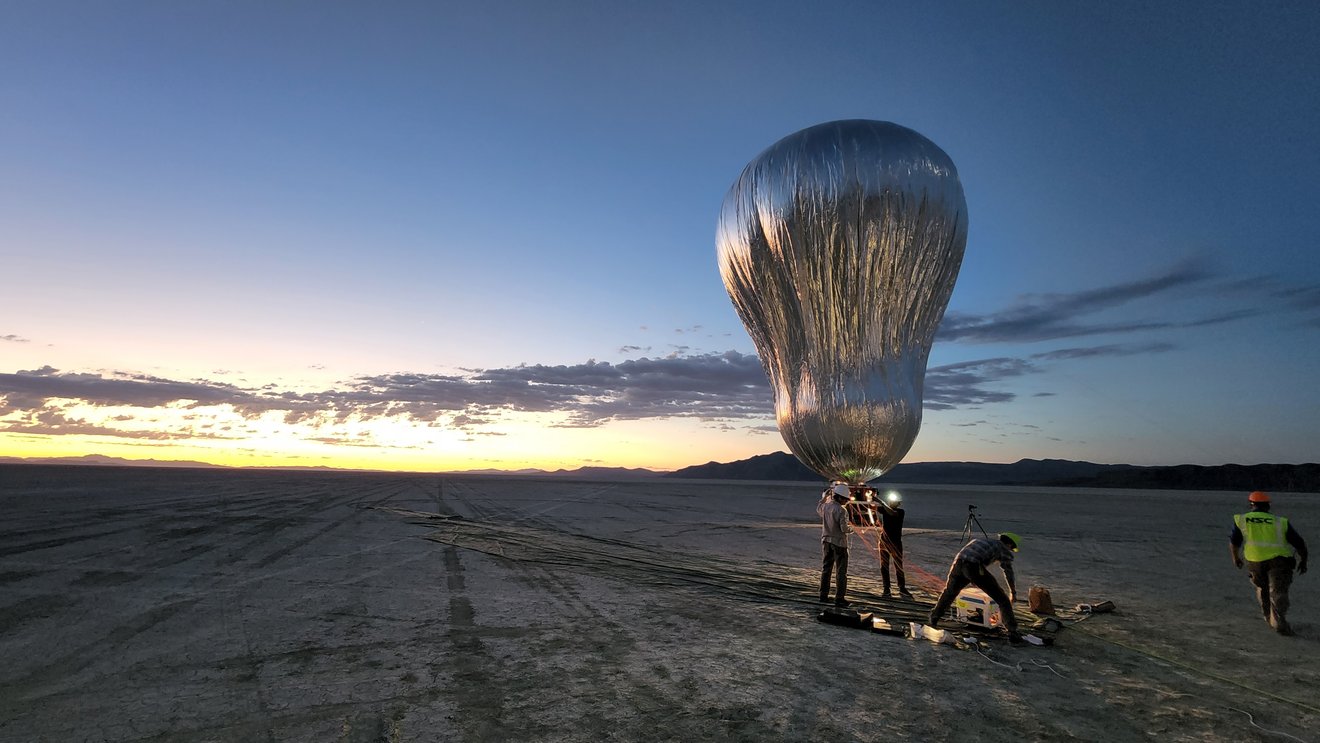Venus balloon prototype notches test flights over Nevada desert (video)
If ever selected to fly to Venus, the balloon would cruise between 30 and 40 miles up, an altitude where conditions are similar to Earth.
A prototype for a balloon that could one day cruise through the clouds of Venus, has aced two test flights above Nevada's Black Rock Desert.
Venus' reputation is a formidable one, that of a world of burning heat, crushing air pressure and insufferable carbon dioxide. Yet the environment 4,000 feet (1,200 meters) above Black Rock Desert isn't too dissimilar to what one may find in Venus' atmosphere between 30 and 40 miles (50 to 60 kilometers) above the ground. At this altitude on Venus, the temperature ranges from 32 to 150 degrees Fahrenheit (0 to 65 degrees Celsius), while the air density is about the same as on Earth. All in all it's really quite clement. It is these conditions that have led to speculation that microbial life could survive in Venus' clouds.
The prototype aerobot, which is short for "aerial robotic balloon," is about 12 feet (4 meters) across, and is essentially a balloon within a balloon. The inner balloon contains high-pressure helium, which is less dense than air. To lift the aerobot, the inner balloon vents helium into the flexible outer balloon, which then inflates, increasing the aerobot's overall buoyancy. To descend, the helium is simply pumped back into the inner balloon, causing the outer balloon to contract.
"The success of these test flights is a huge deal for us," Paul Byrne, a planetary scientist at Washington University in St, Louis, Missouri, who is collaborating on the aerobot, said a statement. "We've successfully demonstrated the technology we'll need for investigating the clouds of Venus."
Related: Planet Venus: 20 interesting facts about the scorching world

Designed jointly by NASA's Jet Propulsion Laboratory (JPL) in California and the Near Space Corporation in Oregon, the aerobot that flew over Black Rock Desert does not mimic any mission yet selected by NASA to go to Venus. However, should such a mission launch, the aerobot would fly to Venus alongside an orbiter spacecraft, which would do its own science and also relay data from the aerobot back to Earth. The final aerobot design would have a diameter of about 40 feet (12 m).
In Venus' atmosphere, the aerobot would float through the clouds, driven onward by the planet's powerful winds. It wouldn't have too much say in where it headed.
Get the Space.com Newsletter
Breaking space news, the latest updates on rocket launches, skywatching events and more!
"The zonal winds — east-to-west — are very strong and consistent on Venus," Jacob Izraelevitz wrote in an email to Space.com. Izraelevitz is a robotics technologist at JPL and the principal investigator on the test flights. "The atmosphere 'super-rotates' with respect to the surface at 60 to 80 meters per second [200 to 260 feet per second] where we would fly. There's no hope of turning the balloon around, and to first order the balloon simply follows the wind."
Balloons have flown on Venus before. In 1985, the Soviet Union launched the twin Vega 1 and 2 missions that each deployed a balloon in Venus' atmosphere. The balloons survived for less than two days before running out of battery power. Izraelevitz says that the aerobot would be solar powered, since even with Venus' thick, cloudy atmosphere, between 30 and 40 miles up there's more than enough sunlight to power a solar mission lasting at least 100 days. Even the problem of clouds laced with deadly sulfuric acid can be negated — Izraelevitz noted that another JPL team is developing solar panels that are resistant to acid erosion.
While the aerobot drifting through the Venusian clouds would not require propulsion, the solar panels would generate energy for the arsenal of scientific instruments the aerobot would carry. These devices would range from mass spectrometers that could sample and analyze the constituents of the atmosphere to detectors that could measure acoustic waves reverberating through the thick atmosphere, perhaps from quakes on the surface. With the recent controversial detection of phosphine in Venus' atmosphere, and the potential biological implications of that discovery, life-detecting experiments would also be important cargo.
Currently, NASA has two missions to Venus in development — DAVINCI (Deep Atmosphere Venus Investigation of Noble Gases, Chemistry and Imaging), which will drop a probe into Venus' atmosphere in 2031, and VERITAS (Venus Emissivity, Radio Science, InSAR, Topography and Spectroscopy), which is an orbiter that will launch for Venus in December 2027. The European Space Agency also has a new Venus mission, EnVision, which will launch in the early 2030s, and the next decade is already being hailed as the "decade of Venus exploration." However, none of the aforementioned missions will carry an aerobot, meaning our balloon adventures on Venus will have to wait a little while longer.
Nevertheless, when that day comes, the aerobot will be ready.
"We're extremely happy with the performance of the prototype," Izraelevitz said in the statement.
Follow Keith Cooper on Twitter @21stCenturySETI. Follow us on Twitter @Spacedotcom and on Facebook.
Join our Space Forums to keep talking space on the latest missions, night sky and more! And if you have a news tip, correction or comment, let us know at: community@space.com.

Keith Cooper is a freelance science journalist and editor in the United Kingdom, and has a degree in physics and astrophysics from the University of Manchester. He's the author of "The Contact Paradox: Challenging Our Assumptions in the Search for Extraterrestrial Intelligence" (Bloomsbury Sigma, 2020) and has written articles on astronomy, space, physics and astrobiology for a multitude of magazines and websites.









